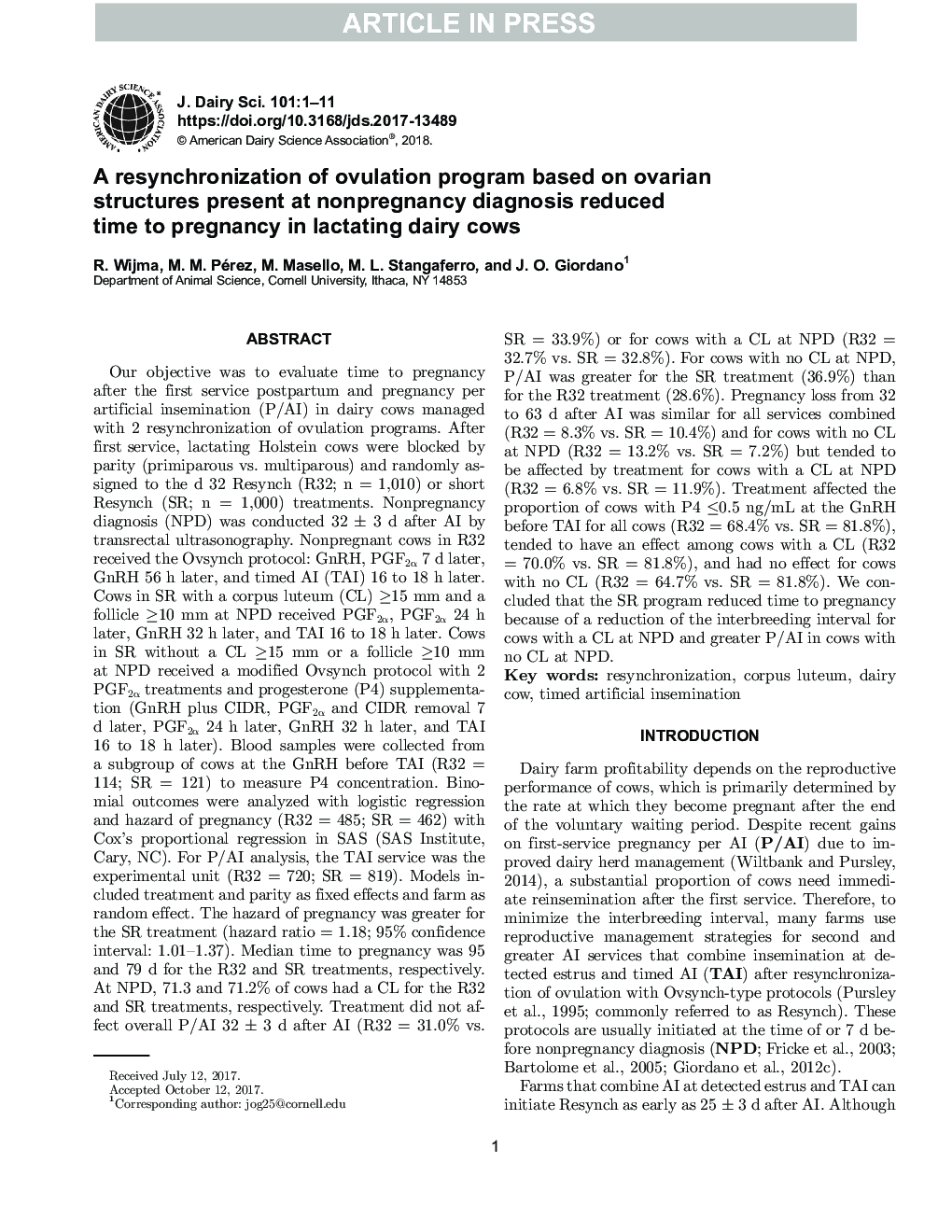| کد مقاله | کد نشریه | سال انتشار | مقاله انگلیسی | نسخه تمام متن |
|---|---|---|---|---|
| 8501750 | 1553843 | 2018 | 11 صفحه PDF | دانلود رایگان |
عنوان انگلیسی مقاله ISI
A resynchronization of ovulation program based on ovarian structures present at nonpregnancy diagnosis reduced time to pregnancy in lactating dairy cows
ترجمه فارسی عنوان
تجویز مجدد برنامه تخمک گذاری بر اساس ساختار تخمدان در تشخیص عدم آمادگی، زمان بارداری در گاو شیرده را کاهش می دهد
دانلود مقاله + سفارش ترجمه
دانلود مقاله ISI انگلیسی
رایگان برای ایرانیان
کلمات کلیدی
موضوعات مرتبط
علوم زیستی و بیوفناوری
علوم کشاورزی و بیولوژیک
علوم دامی و جانورشناسی
چکیده انگلیسی
Our objective was to evaluate time to pregnancy after the first service postpartum and pregnancy per artificial insemination (P/AI) in dairy cows managed with 2 resynchronization of ovulation programs. After first service, lactating Holstein cows were blocked by parity (primiparous vs. multiparous) and randomly assigned to the d 32 Resynch (R32; n = 1,010) or short Resynch (SR; n = 1,000) treatments. Nonpregnancy diagnosis (NPD) was conducted 32 ± 3 d after AI by transrectal ultrasonography. Nonpregnant cows in R32 received the Ovsynch protocol: GnRH, PGF2α 7 d later, GnRH 56 h later, and timed AI (TAI) 16 to 18 h later. Cows in SR with a corpus luteum (CL) â¥15 mm and a follicle â¥10 mm at NPD received PGF2α, PGF2α 24 h later, GnRH 32 h later, and TAI 16 to 18 h later. Cows in SR without a CL â¥15 mm or a follicle â¥10 mm at NPD received a modified Ovsynch protocol with 2 PGF2α treatments and progesterone (P4) supplementation (GnRH plus CIDR, PGF2α and CIDR removal 7 d later, PGF2α 24 h later, GnRH 32 h later, and TAI 16 to 18 h later). Blood samples were collected from a subgroup of cows at the GnRH before TAI (R32 = 114; SR = 121) to measure P4 concentration. Binomial outcomes were analyzed with logistic regression and hazard of pregnancy (R32 = 485; SR = 462) with Cox's proportional regression in SAS (SAS Institute, Cary, NC). For P/AI analysis, the TAI service was the experimental unit (R32 = 720; SR = 819). Models included treatment and parity as fixed effects and farm as random effect. The hazard of pregnancy was greater for the SR treatment (hazard ratio = 1.18; 95% confidence interval: 1.01-1.37). Median time to pregnancy was 95 and 79 d for the R32 and SR treatments, respectively. At NPD, 71.3 and 71.2% of cows had a CL for the R32 and SR treatments, respectively. Treatment did not affect overall P/AI 32 ± 3 d after AI (R32 = 31.0% vs. SR = 33.9%) or for cows with a CL at NPD (R32 = 32.7% vs. SR = 32.8%). For cows with no CL at NPD, P/AI was greater for the SR treatment (36.9%) than for the R32 treatment (28.6%). Pregnancy loss from 32 to 63 d after AI was similar for all services combined (R32 = 8.3% vs. SR = 10.4%) and for cows with no CL at NPD (R32 = 13.2% vs. SR = 7.2%) but tended to be affected by treatment for cows with a CL at NPD (R32 = 6.8% vs. SR = 11.9%). Treatment affected the proportion of cows with P4 â¤0.5 ng/mL at the GnRH before TAI for all cows (R32 = 68.4% vs. SR = 81.8%), tended to have an effect among cows with a CL (R32 = 70.0% vs. SR = 81.8%), and had no effect for cows with no CL (R32 = 64.7% vs. SR = 81.8%). We concluded that the SR program reduced time to pregnancy because of a reduction of the interbreeding interval for cows with a CL at NPD and greater P/AI in cows with no CL at NPD.
ناشر
Database: Elsevier - ScienceDirect (ساینس دایرکت)
Journal: Journal of Dairy Science - Volume 101, Issue 2, February 2018, Pages 1697-1707
Journal: Journal of Dairy Science - Volume 101, Issue 2, February 2018, Pages 1697-1707
نویسندگان
R. Wijma, M.M. Pérez, M. Masello, M.L. Stangaferro, J.O. Giordano,
